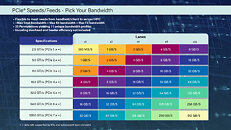- Joined
- Oct 9, 2007
- Messages
- 47,538 (7.47/day)
- Location
- Hyderabad, India
| System Name | RBMK-1000 |
|---|---|
| Processor | AMD Ryzen 7 5700G |
| Motherboard | ASUS ROG Strix B450-E Gaming |
| Cooling | DeepCool Gammax L240 V2 |
| Memory | 2x 8GB G.Skill Sniper X |
| Video Card(s) | Palit GeForce RTX 2080 SUPER GameRock |
| Storage | Western Digital Black NVMe 512GB |
| Display(s) | BenQ 1440p 60 Hz 27-inch |
| Case | Corsair Carbide 100R |
| Audio Device(s) | ASUS SupremeFX S1220A |
| Power Supply | Cooler Master MWE Gold 650W |
| Mouse | ASUS ROG Strix Impact |
| Keyboard | Gamdias Hermes E2 |
| Software | Windows 11 Pro |
PCI-SIG today announced that the PCI Express (PCIe ) 7.0 specification will double the data rate to 128 GT/s and is targeted for release to members in 2025. "For 30 years the guiding principle of PCI-SIG has been, 'If we build it, they will come,'" observed Nathan Brookwood, Research Fellow at Insight 64. "Early parallel versions of PCI technology accommodated speeds of hundreds of megabytes/second, well matched to the graphics, storage and networking demands of the 1990s.
In 2003, PCI-SIG evolved to a serial design that supported speeds of gigabytes/second to accommodate faster solid-state disks and 100MbE Ethernet. Almost like clockwork, PCI-SIG has doubled PCIe specification bandwidth every three years to meet the challenges of emerging applications and markets. Today's announcement of PCI-SIG's plan to double the channel's speed to 512 GB/s (bi-directionally) puts it on track to double PCIe specification performance for another 3-year cycle."


PCI-SIG technical workgroups will be developing the PCIe 7.0 specification with the following feature goals:
The PCIe 7.0 specification is targeted to support emerging applications such as 800 G Ethernet, AI/ML, Cloud and Quantum Computing; and data-intensive markets like Hyperscale Data Centers, High-Performance Computing (HPC) and Military/Aerospace.
View at TechPowerUp Main Site
In 2003, PCI-SIG evolved to a serial design that supported speeds of gigabytes/second to accommodate faster solid-state disks and 100MbE Ethernet. Almost like clockwork, PCI-SIG has doubled PCIe specification bandwidth every three years to meet the challenges of emerging applications and markets. Today's announcement of PCI-SIG's plan to double the channel's speed to 512 GB/s (bi-directionally) puts it on track to double PCIe specification performance for another 3-year cycle."


PCI-SIG technical workgroups will be developing the PCIe 7.0 specification with the following feature goals:
- Delivering 128 GT/s raw bit rate and up to 512 GB/s bi-directionally via x16 configuration
- Utilizing PAM4 (Pulse Amplitude Modulation with 4 levels) signaling
- Focusing on the channel parameters and reach
- Continuing to deliver the low-latency and high-reliability targets
- Improving power efficiency
- Maintaining backwards compatibility with all previous generations of PCIe technology
The PCIe 7.0 specification is targeted to support emerging applications such as 800 G Ethernet, AI/ML, Cloud and Quantum Computing; and data-intensive markets like Hyperscale Data Centers, High-Performance Computing (HPC) and Military/Aerospace.
View at TechPowerUp Main Site









